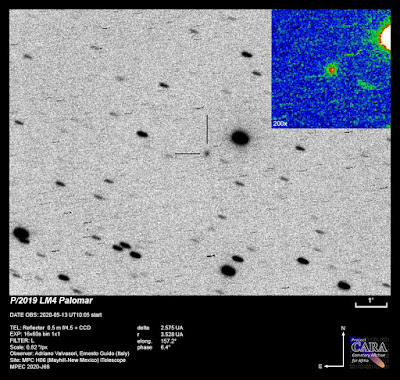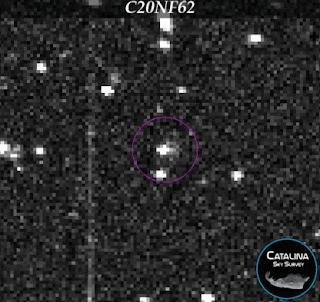Below you can find a new selection (part I available here) of some objects for which we recently made follow-up observations at the "Osservatorio Salvatore di Giacomo, Agerola, ITALY" (MPC code L07; Observers E. Guido, A. Catapano, F. Coccia) while they still were on the NEOCP list. More details about the telescope, the magnitude, number of images & exposition, asteroid speed & PA etc. are on the images. Click on each image for a bigger version. All the processing has been made with TYCHO software by D. Parrott.
COMET C/2020 V2 (ZTF), (neocp designation ZTF0G6I). Stacking of 25 unfiltered exposures, 120 seconds each, obtained remotely on 2020, Nov. 19.1 from L07 (Osservatorio Salvatore di Giacomo, Agerola) through a 0.5 m f/8 Ritchey Chretien + CCD, showed that this object is a comet with a diffuse coma about 7" in diameter and FWHM 3.3" compared to the average value of 2.1" for the stars of same magnitude.
2020 WH1 (neocp designation SaSza42) is an Apollo-type asteroid discovered by K88 GINOP-KHK, Piszkesteto, observer R. Szakats on November 17, 2020. This asteroid has an estimated size of 33 m - 73 m (H=24.6) and it had a close approach with Earth at about 11.5 LD (Lunar Distances = ~384,000 kilometers) or 0.029 AU (1 AU = ~150 million kilometers) at 0824 UT on 09 Nov. 2020.
2009 WY7 (neocp designation Sar2518) is an Aten-type asteroid (First observed at Lincoln Laboratory ETS, New Mexico on 2009-11-19) recovered by K88 GINOP-KHK, Piszkesteto, observer K. Sarneczky on November 22, 2020. This asteroid has an estimated size of 40 m - 90 m (H=24.1) and it had a close approach with Earth at about 20.17 LD (Lunar Distances = ~384,000 kilometers) or 0.05184 AU (1 AU = ~150 million kilometers) at 1104 UT on 24 Nov. 2020.
2020 WO3 (neocp designation C3ZZY12) is an Aten-type asteroid discovered by G96 Mt. Lemmon Survey on November 22, 2020. This asteroid has an estimated size of 67 m - 150 m (H=23.0) and it had a close approach with Earth at about 40.26 LD (Lunar Distances = ~384,000 kilometers) or 0.10345 AU (1 AU = ~150 million kilometers) at 1911 UT on 28 Nov. 2020.
2020 WW3 (neocp designation C417PE2) is an Aten-type asteroid discovered by G96 Mt. Lemmon Survey on November 24, 2020. This asteroid has an estimated size of 20 m - 45 m (H=25.6) and it had a close approach with Earth at about 9.12 LD (Lunar Distances = ~384,000 kilometers) or 0.02344 AU (1 AU = ~150 million kilometers) at 0243 UT on 23 Nov. 2020.
by Ernesto Guido















































